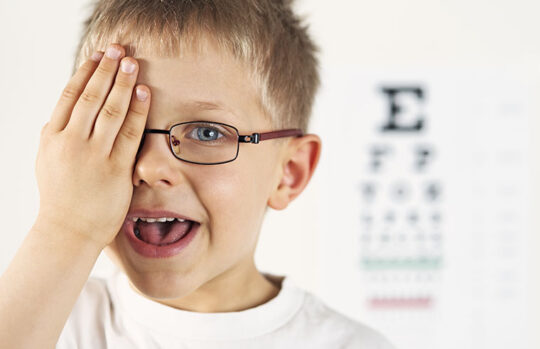“Is there a problem with his eyesight?” The vision red flags not to ignore

If you are reading this, chances are you might be concerned about how your child is seeing.
“Does he need glasses? Is this normal?” you may have asked yourself.
A good motto in these times is always, ‘When in doubt, check it out’ – because that’s the best way to get answers. But this is especially the case with vision impairment, as early intervention can be life-changing.
Here are a few things to know about vision in kids, as well as some vision red flags you shouldn’t ignore.
Vision problems in children
Some children, just like lots of adults, can experience vision impairment.
This can range from no vision (blindness) and or very low vision, to not being able to see colours (colour blindness), having blurry vision, a lazy eye, or not having the full visual field (for example, not having all of their peripheral vision), as well as many other problems with their eyesight.
While a baby might have a vision impairment detected at birth, some kids can develop problems with their eyesight later in life.

Common causes of vision problems in kids
The most common causes of vision impairment include:
- Neurological conditions that affect the parts of the brain that control sight.
- Genetic conditions, such as albinism.
- Illnesses, such as paediatric glaucoma, cataracts or certain cancers like retinoblastoma.
- Infections or viruses during pregnancy that can affect fetal eye development – for example, rubella, cytomegalovirus, toxoplasmosis, and so on.
- Structural problems with the eyes or pathways that limit vision.
- Being long or short-sighted and needing glasses to correct this.
Vision problem red flags in babies
Vision problems in babies can be harder to detect, but some red flags include:
- Trouble focusing. A baby with vision impairment may have trouble focusing. Most babies start to focus on faces and objects by 4-5 weeks of age, and many are smiling at familiar faces by about 6-8 weeks.
- Eyes that move quickly from side to side, jerk or wander randomly.
- Eyes that don’t follow your face or an object, or make contact with very familiar faces when close.
- Eyes that don’t react to a bright light being turned on.
- White or cloudy pupils.
- Eyes that turn towards the nose or drift outwards.
Vision problem red flags in children
Many kids with eyesight problems can look ‘normal’. Their eyes appear fine, but their behaviour is different to other little ones with no vision problems.
These include:
- Needing to hold toys and objects up to his face to see them.
- Covering one eye when looking at things up close or turning or tilting his head.
- Getting tired after looking at things – for example, drawing.
- Rubbing eyes a lot.
- Seeming to see better during the day than at night.
- Poor hand/eye coordination.
- Needing to sit very close to the television, or holding a book close to his eyes.
- Having crossed or turned eyes or a squint (lazy eye)
- Seeming clumsy – for example, he might knock things over or trip often.
- Telling you the words in a book appear fuzzy or that he can see double or has trouble seeing things far away.
- Complains of headaches and eye discomfort.
- Seems sensitive to light.
Who can help?
If you are worried about how your little one is seeing, it’s always a good idea to have his vision checked.
Vision problems can affect learning and childhood development in a range of areas, so early intervention if there is a problem is essential.

You could see your GP or paediatrician first up, who can refer you to a paediatric ophthalmologist if need be. The ophthalmologist will examine your child and do tests to work out what the problem is.
An optometrist can also check your child’s vision and assess him for glasses if need be, or suggest you see an ophthalmologist.
While you don’t need a GP referral to take your child to an optometrist, your GP is always a good starting point when it comes to any health concern you have for your child.
If it turns out that your child is short or long-sighted or has an astigmatism and needs glasses, an optometrist can prescribe these to correct the problem.
Some other eye problems in children can also be treated with eye exercises, and some can be prevented or treated if picked up early. There’s also lots of early intervention and help available if your child is vision impaired that will assist him with learning and development.
It’s recommended that children get their vision checked every two years, especially if there is a family history of vision problems.
 Need some support to be the best parent you can be? Our Parent School parent coaching experts can help. Click to find out more or book a one-on-one session.
Need some support to be the best parent you can be? Our Parent School parent coaching experts can help. Click to find out more or book a one-on-one session.










